|
When the foot is forcefully externally rotated fracture rupture of
ligaments of the ankle or fracture of their attachments to bone may
occur. If the foot is supinated the lateral structures will break
first as they are in tension. If the lateral structures are relaxed
because the foot being pronated the medial structures will fail first.
Patients seldom remember the position their foot was in when it was
injured. For this reason the Weber classification is more practical.
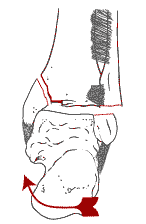 |
| Weber A. Comminution is medial |
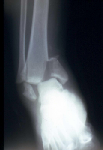 |
| Weber A: Click
to show other examples |
Weber A:
- Fibula
- Transverse fracture at level of ankle joint
- Medial malleolus
- Transverse vertical fracture
- Posterior malleolus
- Intact
- Syndesmosis
- Intact
Weber B:
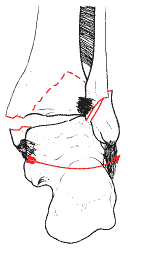 |
| Weber B
Comminution is lateral. Fibula fracture starts
at joint level |
- Fibula
- Spiral fracture - begins at ankle joint level
- Medial Malleolus
- Intact or avulsion fracture
- Posterior malleolus
- Intact or avulsion fracture (posterior tib-fib ligament )
- Anterior syndesmosis
- Intact (as well as the anterior tib fib ligament - this is why
the fracture of the fibula begins here. The lateral side is last
to rupture. If this ligament holds and the fibula fractures at this
stress raiser higher disruptions such as the interosseous ligament
cannot take place.
If the displacing forces are insufficient only partial progression
to the full blown cases above will occur. E.g. An isolated lateral
malleolus fracture may be an incomplete Weber A , but it could also
be a occult Weber B or C where the only bony fracture is of the distal
fibula. Check for tenderness of the medial malleolus to test if the
deltoid ligament is ruptured. If the fracture starts at the ankle
and runs proximal to the joint it is a Weber B, if the fracture of
the fibula is above the syndesmosis the fracture is classified as
Weber C.
Weber C:
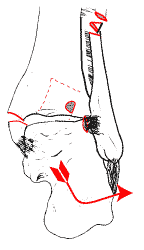 |
| Weber C: Fibula
fracture is above ankle joint |
- Fibula
- Spiral fracture above the syndesmosis
- Medial Malleolus
- Transverse fracture or rupture of the deltoid ligament
- Posterior Malleolus
- Posterior syndesmosis ruptured an avulsion of the posterior malleolus
Weber c: fractures are also known as the Dupytren's fracture.
A high fibula fracture (near the fibular neck) is known as a Maisonneuve
fracture. Always examine the ankle when you see a spiral fracture
of the fibular neck. Tenderness of the medial malleolus may mean a
rupture of the deltoid ligament, even if the x rays appear normal.
A stress x ray of the ankle may be needed under general anaesthetic
to demonstrate the disruption of the syndesmosis.
Management
 |
| Order of failure
in a Weber C fracture (seen from behind) is from medial to lateral |
If the hind foot shows obvious mal alignment reduce the ankle even
before taking X rays. A rough reduction can be accomplished simply
by grasping the heel, and reducing the posterior subluxation, and
then reducing the varus or valgus mal alignment.
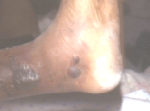 |
| Fracture blisters: Early reduction
may prevent them |
Early reduction is important in preventing complications such as
gross swelling and fracture blisters, which will prevent early internal
fixation. The casualty officer must ensure that all ankle fractures
are grossly reduced, even if he intends referring the patient elsewhere
for definitive treatment. An accurate reduction of under 2 mm displacement
id difficult to achieve and for this reason most bimalleolar and displaced
fractures will need internal fixation.
X Ray Examination
AP, Lateral and Mortise views are required.
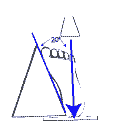 |
| Mortise view, taken with foot
in 20 deg internal rotation |
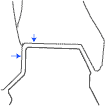 |
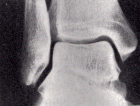 |
| On the Mortise
view, the talus must be central, with equal space
between the talus and the two malleoli, as well as the tibial
plafond above |
Conservative treatment
Candidates for closed reduction are ankle fractures that can be reduced
to less than 2 mm of anatomical position. This can be achieved with
minimally displaced isolated lateral or medial malleolar fractures,
but is difficult with most bi malleolar cases.
The fracture is manipulated under adequate analgesia or general anaesthetic.
A below knee plaster cast is applied with the foot in the opposite
position as the initial displacing force to relax ruptured ligaments
and close the fracture.
Surgical Treatment
Most displaced fractures will require surgery. If your hospital does
not have the expertise or facilities to do open reduction and internal
fixation. Reduce the fracture, and place the limb in a back slab to
stabilise before referral.
The ideal time for Open Reduction and Internal Fixation (ORIF) is
immediately but, if there is significant swelling operation must be
delayed until swelling subsides in a few days. Fracture blisters are
a contraindication to surgery. Open fractures ( the ankle subcutaneous
and these injuries are common) are debrided reduced and definitive
ORIF is done at 48 hours, or whenever the wounds are deemed sterile
enough to close the skin.
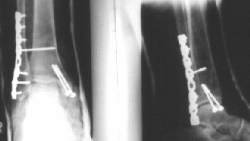 |
Open reduction of a Weber C fracture. A syndesmosis
screw bridges the fibula and tibia to reconstruct the ruptured |
The medial malleolus needs to be fixed with one or two screws. The
lateral malleolus is usually shortened and or displaced laterally.
Once the fibula is pulled out length and the fracture reduced a plate
and screws are used to stabilise it. In Weber C fractures the syndesmosis
is stabiles ed by a "syndesmosis" screw between
the plate on the lateral side and the outer cortex of the fibula.
It is placed about 1.5 cm above the ankle joint.
Fracture dislocations of the ankle
Dislocations of the ankle are often open. It is unusual to get a
dislocation without a fracture of one or both malleoli. Reduce and
treat as an open ankle fracture with debridement and secondary ORIF.
Prognosis
Late onset of osteoarthritis is rare if the ankle is reduced satisfactorily.
Osteochondral damage such as seen often in a Weber A fracture carries
a poorer prognosis. |